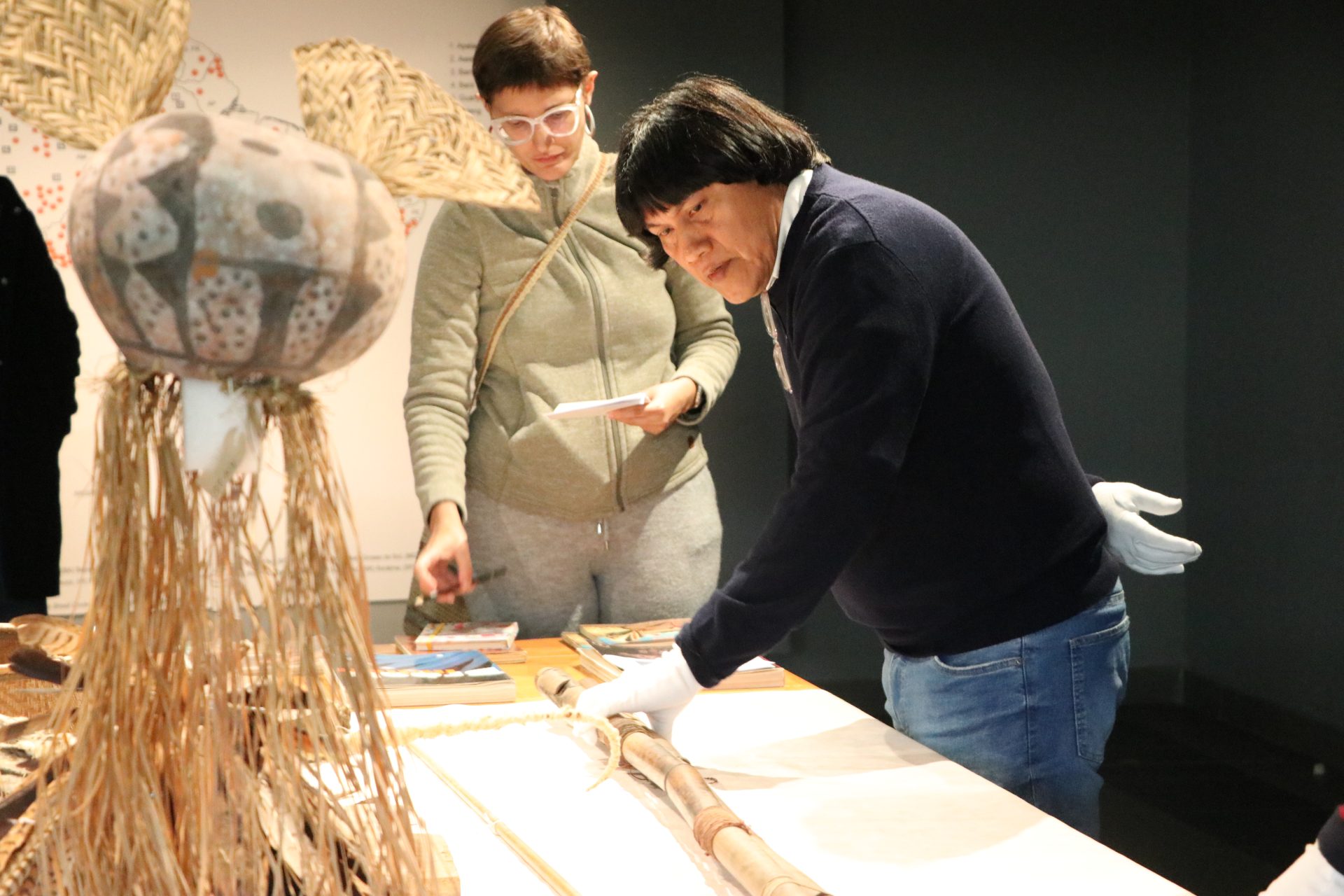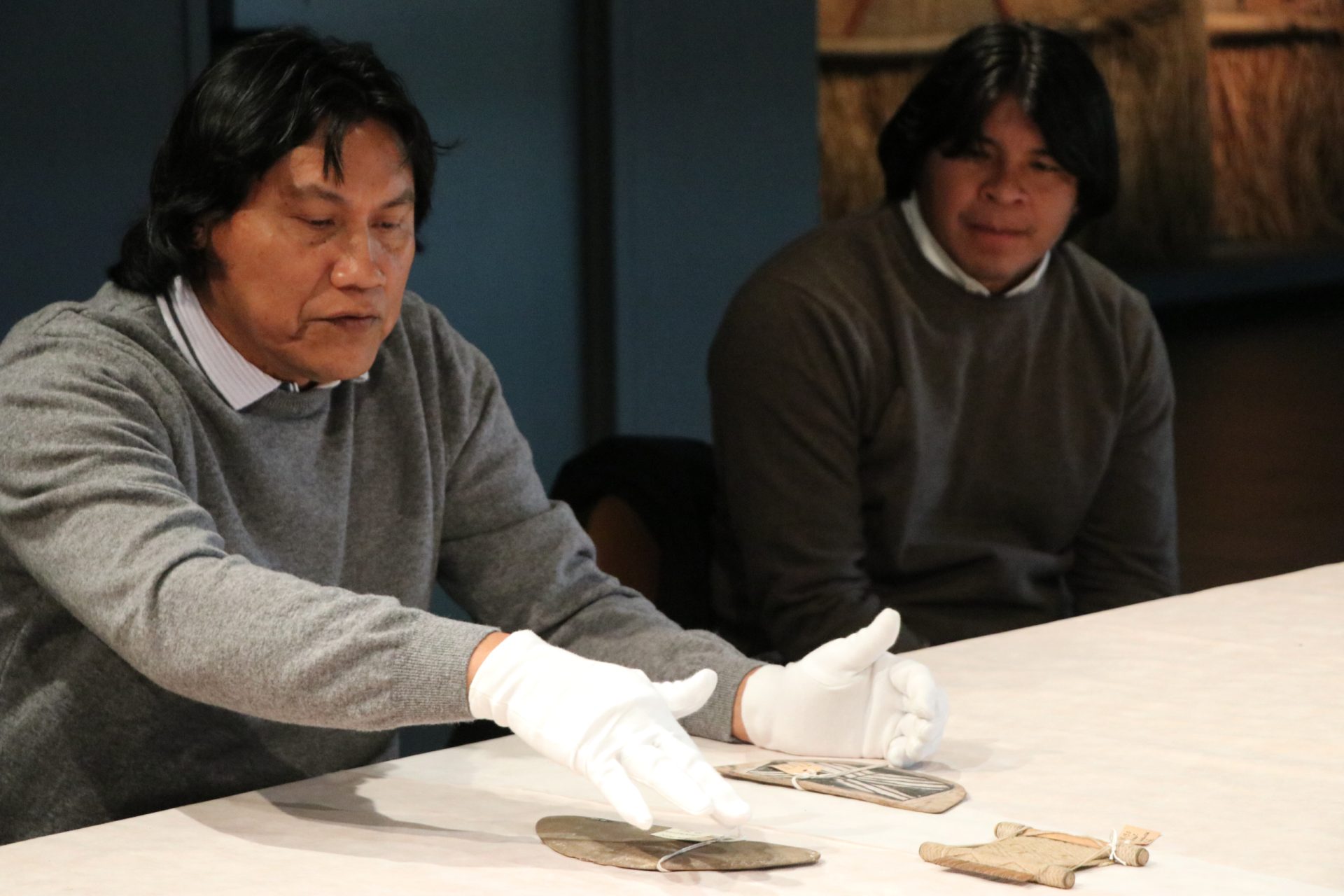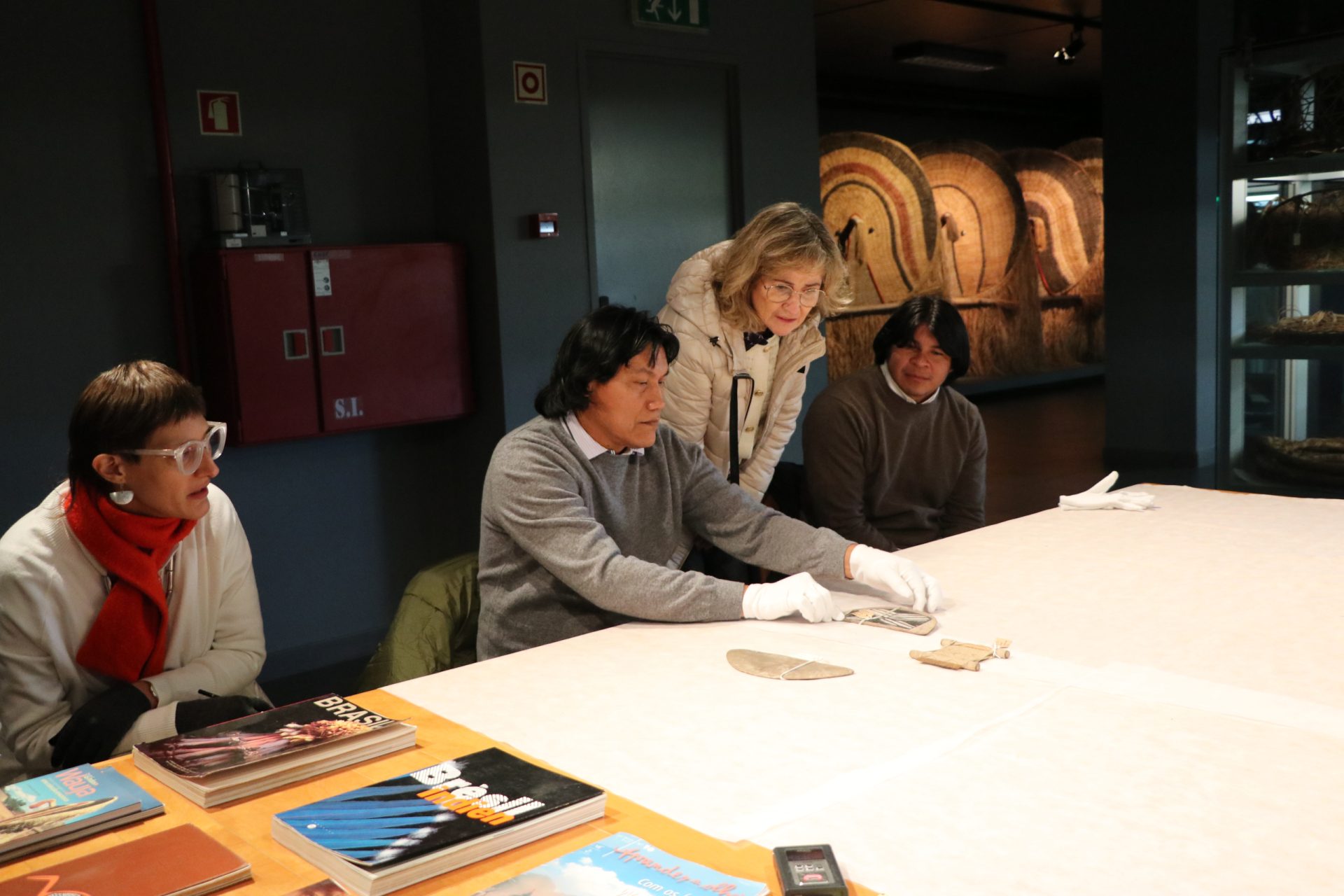Project InDigit consultants and co-researchers Kanawayuri Marcelo Kamaiurá and Auakamu Kamayurá, representatives of the Kamayurá Archive, from the Kamayurá indigenous people, travelled to Portugal at the end of February to take part in a collaborative museology workshop regarding the collection obtained in 1964 by Victor and Françoise Bandeira, while visiting the Ipavu village, for the National Museum of Ethnology, located in Lisbon.
Hosted by the museum as part of IN2PAST exploratory project InDigit, the 2-day workshop allowed researchers, and museum curators and technicians, to contextualise the collection in more detail, and to reflect on archival practice, museography and artefact conservation together with the Kamayurá representatives.
For Kanawayuri Marcelo and Auakamu, the workshop was also a chance to learn about the conservation techniques used in the museum and to take part in discussions about care regimes – which include considerations of visuality (what should and should not be seen and by whom), ways of displaying objects and access policies.
The Kamayurá Archive project consisted of visiting the collections of the main Brazilian anthropologists who worked with this people since the 1960s, and memory institutions, and digitally returning documents considered relevant to the community. One of the project’s conclusions, says InDigit PI Rodrigo Lacerda (CRIA – NOVA FCSH / IN2PAST), is that the Kamayurá’s visits to the archives allow them to learn about new technologies, gather contextual information and establish new relationships with the people and institutions involved.
The main objective of project InDigit, approved in last year’s call for funding of exploratory projects, is to examine the differences and similarities between the theories and practices of the museum and the Kamayurá in terms of classification systems, access protocols, concepts of ownership, care regimes and notions of temporality. InDigit’s end goal is to develop a prototype digital repository based on the Kamayurá collection at the National Museum of Ethnology (NME) in collaboration with the Kamayurá people, who live in the Upper Xingu in Brazil.
Taking part in the collaborative museology workshop held on February 27th and 28th were also the NME director, Gonçalo Amaro, researcher at IHC – NOVA FCSH / IN2PAST, and museum team members Alexandre Weffort (coordination), Alexandra Oliveira (documentation), Alexandre Raposo (logistics), Daniel Meira (communication), Iria Simões (photographic record), Raquel Ferreira (conservation), and Sónia Henrique (collections management).
Accompanying Rodrigo were project Co-PI Elisabete Pereira (IHC – University of Évora / IN2PAST), Luísa Valentini (CNPq / UFBA), who has supported the Kamayurá Archive project for more than a decade, and CRIA – NOVA FCSH / IN2PAST researcher João Leal. InDigit team further includes IHC – NOVA FCSH / IN2PAST researchers Ângela Salgueiro and Joana Paulino, and Lab2PT – University of Minho / IN2PAST researcher Paulo Bernardes.

Anthropologist Luísa Valentini and Kanawayuri Marcelo Kamaiurá, © Iria Simões, MNE/ ADF/ Museus e Monumentos de Portugal, E.P.E.

Kanawayuri Marcelo Kamaiurá and Auakamu Kamayurá © Iria Simões, MNE/ ADF/ Museus e Monumentos de Portugal, E.P.E.

LEFT TO RIGHT Luísa Valentini, Kanawayuri Marcelo Kamaiurá, Elisabete Pereira, and Auakamu Kamayurá © Iria Simões, MNE/ ADF/ Museus e Monumentos de Portugal, E.P.E.
The collaborative museology workshop focused on the Kamayurá collection gathered by Victor and Françoise Bandeira in 1964-65, during their visit to the Ipavu village of the Kamayurá people, as part of the couple’s trip to Latin America to collect elements of tangible culture for the Overseas Ethnology Museum (then a project; now the NME), at the request of its founder, anthropologist Jorge Dias. The Kamayurá’s visit also included a general tour of the museum, including the exhibitions and the various technical reserve collections.
The workshop ‘achieved the intended success thanks to the long-standing work of the Kamayurá Archive project,’ says Rodrigo Lacerda. ‘As Kanawayuri Kamaiurá and Mayaru Kamayurá explain in the paper ‘Arquivo Kamayurá: pesquisa, documentação e transmissão da memória’, published in 2023 in Boletim do Museu Paraense Emílio Goeldi,
‘The Kamayurá Archive project was designed by leaders of the two main villages of the Kamayurá ethnic group in the Xingu Park, Mato Grosso, called Ypavu and Morená. We seek to complement knowledge of the history of the Kamayurá people and to develop new policies and strategies for safeguarding and transmitting knowledge for our future.
This project is built on research carried out by an indigenous team and extensive discussion within the Kamayurá community. The first stage of the research, carried out in 2019, consisted of visiting researchers who have been working with the Kamayurá since the 1960s and memory institutions, to learn about historical records, how they were made and used, and how they are preserved.’ (Kamaiurá, Kamayurá, 2023: 1)
Continuing this productive collaboration between the Kamayurá Archive, the NME and the InDigit team, the next steps for IN2PAST’s exploratory project are: the collaborative creation of a prototype digital repository for the NME collection, from the perspective of the Kamayurá people; the joint drafting of a manual with recommendations from the Kamayurá on the management of their people’s collections, both in physical and digital formats; and the publication of a collaborative reflection paper on the project.
‘This work not only demonstrates the importance of ethnographic museums and the collections they preserve for the communities of origin today, but also illustrates how these institutions can renew and reinvent themselves through these intersections of experiences,’ says InDigit’s PI.
2025 © IN2PAST. All rights reserved.
IN2PAST – Associate Laboratory for Research and Innovation in Heritage, Arts, Sustainability and Territory is funded by FCT – Fundação para a Ciência e a Tecnologia, I. P. under reference LA/P/0132/2020 (DOI 10.54499/LA/P/0132/2020)